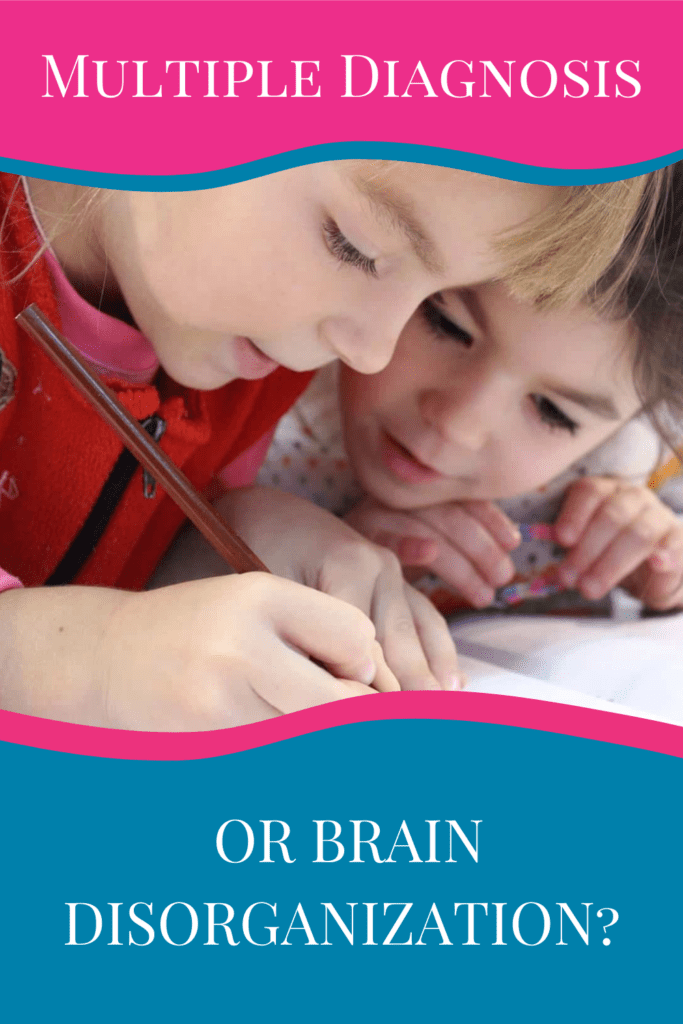The other day I talked to a mom whose daughter is in grade 5 and learned that on top of having dyslexia, dyspraxia and mild ADHD, she also has dyscalculia. The daughter was devastated. The mom was working with a tutor, an OT, the family doctor and now wants to hire a math tutor.
Mom now has two full-time jobs. Her day job – going to appointments.
Your Child’s Brain is Not a Head of Cabbage
Your child’s brain is not a head of cabbage. It needs more than food and water. It is also not an engine where one part can break down and everything else works smoothly. Everything in the brain works together and influences other parts.
Nutrition and gut health aside, one of the main reasons that there is so much overlap with dyslexia and so many other disorders is because the brain is disorganized and there are areas of disconnection.
Science has proven this recently but we haven’t we been saying for years about people with learning difficulties and delays, “there seems to be a real disconnect”?
Understanding the ‘Disconnect’ In Your Child
Teachers see this in the classroom all the time, as do parents. They will say, “my child is intelligent. He can tell you all about such and such a topic but when it comes to putting it on paper he can’t.” Or they will say, “he is incredibly mechanically minded, he can apply it but he can’t explain it.”
When a child is working too hard to learn or read, or trying too hard to manage their behaviour it is because their brain has areas that are underdeveloped. There are areas that are not communicating very well with other parts and thus there is a disconnect and disorganization.
What if Instead of Multiple Diagnoses We Recognised it For What It Is – Brain Disorganization!
The amount of children diagnosed with neuro-developmental disorders has escalated exponentially in the last 30 years. The common idea that these individual disorders occur in isolation from the rest of the brain and creates its own symptoms without having any impact on the rest of the brain and its cognitive and behavioural processes is deeply flawed.
That co-morbid diagnoses are the rule and not the exception shows that these disorders have more to do with a whole body-brain disconnect and disorganization. If these disorders were ‘true’ disorders like chicken pox we wouldn’t so frequently see multiple diagnoses. They would be the exception – and yet they are the rule. Multiple diagnoses, overlap or medically known as co-morbidity is the rule – so much so that it has been a regular topic of research.
Many of these Disorders Have the Same Areas of Impairment in the Brain
These disorders often have several symptoms in common because similar areas of the brain are impaired or underdeveloped. For example, both ADHD and dyslexia involve difficulties with processing speed, working memory, motor deficits and naming speed as well as auditory processing.
Yet the root of all these disorders start in common areas of the brain such as the visual or auditory cortex, the sensory motor system. Interestingly, all these systems work together and develop most rapidly through sensory motor stimulation during infancy. In fact, the brain grows to 90% of its full size from ages 1-3.
The Body Develops the Brain
Dr. Dorman and Dr. Delacato as well as many other experts in the field of neuroplasticity (the science of how the brain can change and heal) have documented time and time again the connection between the brain and the body.
What these researchers found is that when the body moves in certain ways, different areas of the brain are activated, stimulated and developed. When this movement is consistent and repetitive, a certain area of the brain not only becomes activated, it begins to build strong connections and even new neurons.
The Importance of Infant Movements
In fact, it was these same researchers who realised the importance of infant movements on the brain when they were working with brain injured adults. They thought that since their patients had lost basic skills that are developed in infancy that perhaps if they had their patients do the same movements as infants as a form of exercise then they could retrain their brain. The hypothesis was that these patients could regain their skills. The results were astounding.
Stimulating the Sensory-Motor System is Where Brain Development & Better Learning Occurs
Starting in infancy, the brain develops the body. Mountains of evidence have now shown us that movement develops the various areas of the brain like the sensory-motor or visual system. Whether it is with children with learning difficulties or adults with dementia, targeted movements results in areas of the brain that were weak or underdeveloped becoming activated. This movement therapy also resulted in more connections in the brain and improved cognition.
A Whole Brain-Body Perspective
When we look at the dysfunction from a whole-body perspective (that includes the brain because the brain is as much a part of the body as any organ in the body) then we see the problem is not some isolated, imaginary part of the brain that is weak that is causing a reading, learning or behavioural problem. There is an overall dysfunction.
And yet – children rarely have just one area of dysfunction or one disorder. In fact, not only do they have multiple neuro-developmental diagnoses, it is not uncommon for them to have various health issues such as eczema, psoriasis, constipation, diarrhea, picky eating, anxiety and immune issues.
Addressing the Symptom Instead of the Cause
The common approach with these disorders involves addressing the apparent ‘problem’. Dyslexia is the inability to read fluently, ADHD is connected to focus and impulse-control, dyspraxia is coordination and ASD is sensory input, learning ability and socialization.
Instead of trying to tackle each issue as if it is separate, a whole-body, whole-brain approach focuses on addressing the overall dysfunction that is triggering all of this overlap. This begins with re-organizing the brain and addressing areas of underdevelopment via sensory-motor stimulation and exercises.
This approach involves correction rather than the conventional compensations and has been shown both in studies as well as in classrooms throughout North America to yield significantly greater gains than standard reading programs.
To learn more about an approach that combines nutritional therapy with cognitive exercises that re-organize the brain and strengthens weak connections check out my programs Reading Rockstar Bootcamp and The Full Potential Clinic.
Set up a free 20-minute discovery session to learn more about how you can help your child improve their reading comprehension so they can become a fluent reader and a more confident kid.
Sources:
https://www.ncbi.nlm.nih.gov/pmc/articles/PMC4001144/
https://www.mdpi.com/journal/children/special_issues/Dyslexia
https://www.apraxia-kids.org/wp-content/uploads/2012/12/2002-AJR-Handout-FAs-in-DDA.pdf
https://irispublishers.com/ann/pdf/ANN.MS.ID.000585.pdf
http://www.davidpublisher.org/Public/uploads/Contribute/56a9795c3eeae.pdf
https://www.ncbi.nlm.nih.gov/pmc/articles/PMC3845870/
https://www.ncbi.nlm.nih.gov/pubmed/9753595
https://www.ncbi.nlm.nih.gov/pmc/articles/PMC4525418/
http://www.ascd.org/publications/books/104013/chapters/Movement-and-Learning.aspx


